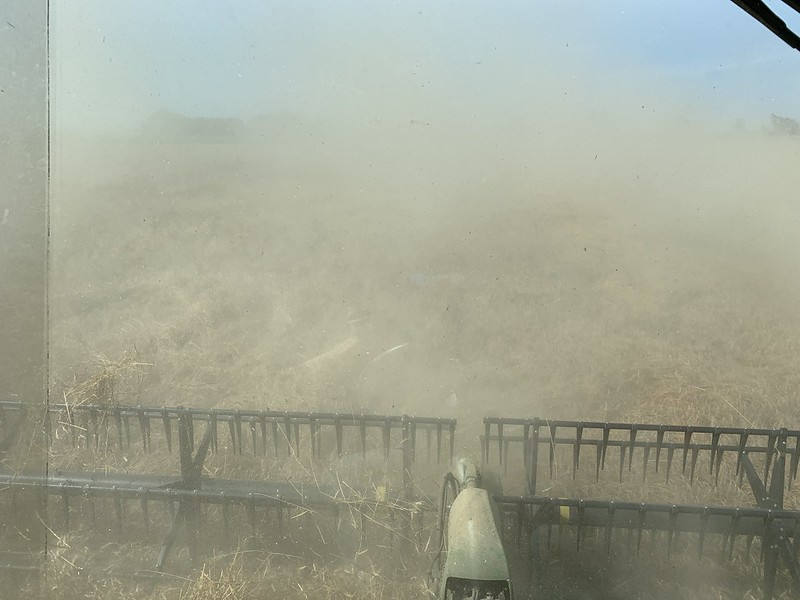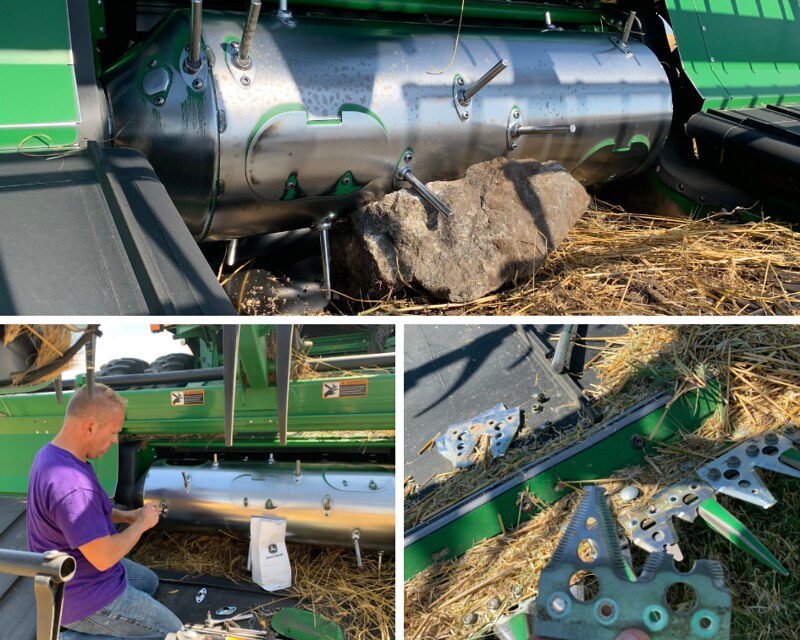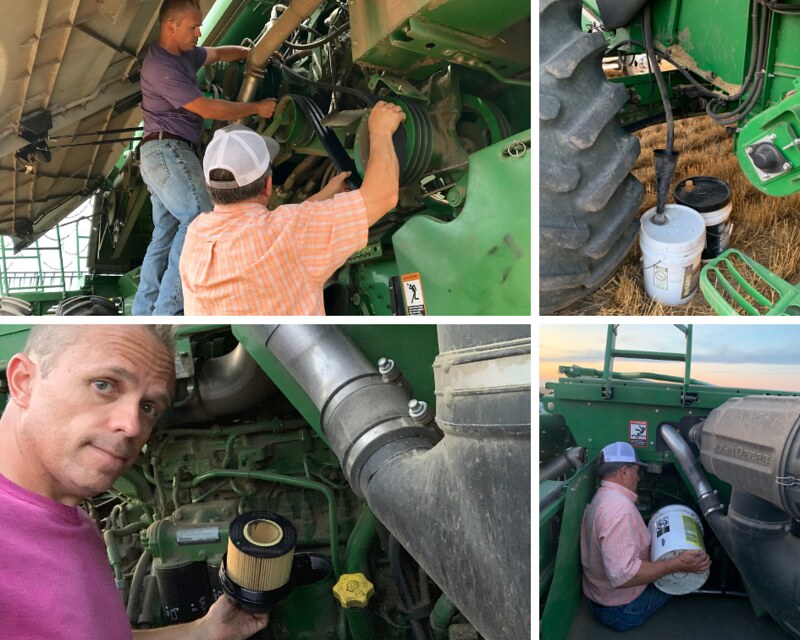
14 Aug Brian: So slow in South Dakota
Onida, South Dakota—When we come to South Dakota we are always prepared to roll up our sleeves and get to work. Serious work. Mile-long fields, big yields, long hauls, late nights and early mornings … this is harvesting on a grand scale, and it can be exhausting. So the fact that we have been here for two weeks and haven’t put in a full day of work yet is unexpected and a little disappointing.
The wide open spaces of South Dakota provide views unlike any other. Golden wheat stands in contrast to the green prairie grasses and blue skies. Country roads run off into the horizon, and seemingly endless fields of wheat stretch for miles in almost every direction.
When the weather gives us short work days, we capitalize on the hours we do spend in the field. Meals on the go are the norm here, keeping everyone working without stopping to eat. As you can see the cooks go out of their way to make sure we don’t suffer lunch-meat-sandwich fatigue. I’m not sure every harvest crew can say that … so shout out to the cooks, Vernelle and Brenda, for delicious meals even when we are on the go!
When your work day revolves around the weather, sometimes your work doesn’t actually last all day. This has been the case since we arrived here in Onida. The unusually cool, damp weather we experienced in Nebraska has followed us to South Dakota it seems. With lows in the 50s and highs that struggle to get into the mid-70s some days, this is not the weather we normally experience here. Add in super-high humidity levels and you get days where harvesting doesn’t start until the afternoon, and conditions get so tough the machines often make the day’s final pass before the sun even goes down. We have seen the thermometer push past 115 degrees F here many times, but this year is the complete opposite.
Everyone remembers the oppressive heat of years gone by—just look at that heat index from 2016—but not this year. While it makes for more comfortable days spent working outside, work days are short and often end before the sun even sets due to the cool, damp conditions every evening. It’s very odd to have this type of weather here during harvest, especially for such a prolonged period of time.
Glen captured this great shot from the elevator as the sun was setting behind the enormous piles of wheat being stored in outdoor bunkers. High yields and the large fields of South Dakota mean finding a place to put all this grain is a challenge. Notice the long line of trucks circling the wheat pile … the number of trucks unloaded here every hour is staggering.
Part of the problem is the extremely dense straw with this year’s crop, and almost all fields have suffered from going down into a tangled mess. This means it’s difficult for sun and wind to dry out the matted crop on the ground. Heavy dew almost every morning simulates a light rain shower. We have even had dense fog a few times, soaking the wheat and putting a halt to harvest for the day. A few light showers have moved through the area as well. It’s extremely dusty and dirty conditions as well.
Fields are extremely dusty and dirty this year, making it virtually impossible to see at times. In the evenings calm winds and damp, humid air cause the dust to stick to the machines and windows, making a terrible mess. With GPS auto steer driving the combine, a lot of stress is removed from the operators, keeping the passes straight and the headers full … otherwise the dirt would leave us driving half blind much of the time.
The extremely heavy crop also has made for very slow harvesting speeds in the combines—2 to 2.5 miles per hour most of the time, nearly half the speed we often can travel. The yields are very good, with 65 to 75 bushels per acre common. Since the wheat has fallen over onto the ground, we must cut very close to the ground, which increases our chances of hitting South Dakota’s infamous rocks. This means we must separate out a lot of grain from a lot of straw. A lack of warm sun and wind keeps the straw pretty tough a majority of the day, consuming a lot of horsepower and fuel. Short working days, together with slow harvest speeds, means our typical daily productivity has been cut nearly in half … for two weeks straight.
It’s easy to see the reason progress has been slow … heavy straw that is down and tangled. It takes a slow speed and a lot of horsepower to separate, process and chop such a dense crop mat. The machines are working overtime, but their capacity to intake such a mess and still capture virtually all the grain is amazing compared to combines from just 20 years ago.
If you have ever been to South Dakota then you have seen the rocks. Farmers work endlessly to get them all picked up, but there is always one or two that gets missed. Since we have to harvest so close to the ground this year, you are bound to find the ones left behind. If you are lucky only a few broken knife sections or steel feed drum fingers are all that need repaired … but the potential for serious damage to the machines always exists.
While we wish we were working harder, it’s hard to deny the slower pace isn’t enjoyable. Mornings are spent sleeping in a little extra. Meals sitting around a real table with air conditioning and no dust or bugs is always a treat. Extra time for maintenance is always appreciated. The crew has enjoyed a few outings around the area to enjoy the scenery, do some shopping and even had a few meals eating out, giving the cooks a long overdue break from the kitchen.
Brian and Glen take advantage of of the free time caused by dewy mornings to leisurely work on the combine. A large drive belt for the straw chopper showed signs of wear and was replaced as a preventative measure. The combine also reached its oil change interval, so a new filter and fresh oil are swapped in. And, yes, at nearly $500 for the belt and 29 quarts of oil, even routine maintenance is expensive!
A family friend that works for Case IH stopped by the field for a day to talk with David about an issue on his new combine, and he gave some pro-tips on using some of the newest technology. Thanks, Ryan! We were really grateful to John Deere Harvester Works Customer Support for helping replace a noisy bearing before it caused any down time. You may not be aware that mobile teams of technicians from the combine factories follows the harvest as it progresses, hopscotching across the midwest helping repair machines and dealing with difficult issues. Semi truck trailers filled with millions of dollars of spare parts are pre-positioned, and these teams are available 24/7 with a special phone number. Electrical problem? Powertrain problem? Hydraulic problem? With a simple phone call these factory repair experts have unlimited access to the engineers and workers that designed and assembled your machine. This pro-level of support is pretty amazing, and harvesters sleep a little better at night knowing extra help to solve a serious problem is only a phone call away. It’s a benefit to the manufacturers as well, as factory technicians can spot repeated failures or misassembled parts quickly, allowing changes to be made back on the assembly line in real-time. Harvesters get quick repairs, and in turn quality improves at the factory—it’s teamwork at its best.

 Nobody can offer help like the pros from the factory. With teams of technicians that eat, sleep and breathe combines if you have a problem, they have the solution. David had some photos taken of an assembly to send back to the factory to examine a possible alignment issue, and John Deere replaced a bearing in the field before we experienced a failure. These services are free to harvesters, and factory support is greatly appreciated when traveling away from home.
Nobody can offer help like the pros from the factory. With teams of technicians that eat, sleep and breathe combines if you have a problem, they have the solution. David had some photos taken of an assembly to send back to the factory to examine a possible alignment issue, and John Deere replaced a bearing in the field before we experienced a failure. These services are free to harvesters, and factory support is greatly appreciated when traveling away from home.
Will the weather shape up in the next week and finally allow us to make some real harvesting progress? If the extended forecast is any indication the answer is no. In fact, a forecasted severe weather system threatens to bring everything to a halt, but you never know exactly where these storm will track. It can get kind of dicey out in the field managing the logistics of keeping everyone safe and dry. Here … let me just show you in the video below what I’m talking about live from the field. Will this system give us a direct hit? Will there be hail, high winds or heavy rain? I’ll be sure to report back soon about the severity of this storm and how it impacts our harvest schedule.
All Aboard Wheat Harvest is sponsored by High Plains Journal and John Deere. Be sure to join the conversation by leaving a question or comment. Brian can be reached at Brian@allaboardharvest.com.









Sorry, the comment form is closed at this time.